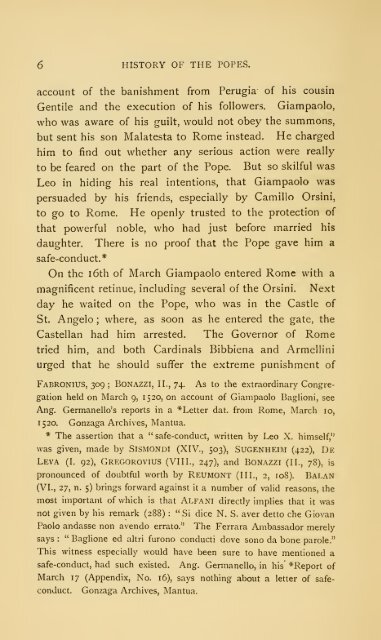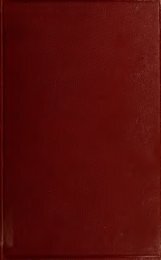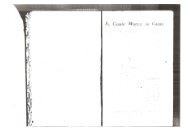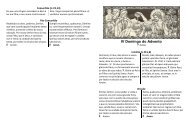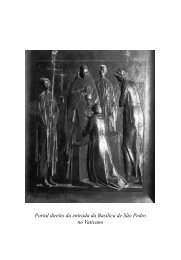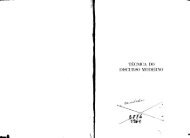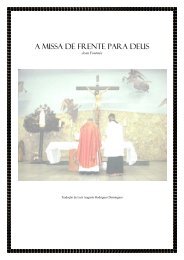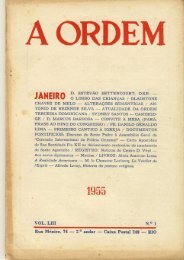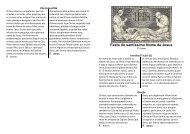- Page 2: PRINCETON, N. J. BX 95L ..„.. i.3
- Page 7: THE * MAR 1 19C HISTORY OF THE POPE
- Page 11 and 12: A.D. TABLE OF CONTENTS OF VOLUME VI
- Page 13 and 14: A.D, TABLE OF CONTENTS. 1521 The at
- Page 15 and 16: A.D. TABLE OF CONTENTS. 15 13 Reven
- Page 17 and 18: A.D. 1520 1521 1520 TABLE OF CONTEN
- Page 19 and 20: TABLE OF CONTENTS. XV A.D. PAGE 152
- Page 21 and 22: A.D. TABLE OF CONTENTS. XVll 15 13
- Page 23 and 24: A.D. TABLE OK CONTENTS. XIX PAGE 15
- Page 25 and 26: A.D. TABLE OF CONTENTS. XXI 15 1 Th
- Page 27: LIST OF UNPUBLISHED DOCUMENTS IN AP
- Page 30 and 31: 2 HISTORY OF THE POPES. of Italy" c
- Page 32 and 33: 4 HISTORY OF THE POPES. measures ag
- Page 36 and 37: 8 HISTORY OF THE POPES. by reading
- Page 38 and 39: 10 HISTORY OF THE POPES. Catherine
- Page 40 and 41: 12 HISTORY OF THE POPES. sequently,
- Page 42 and 43: 14 HISTORY OF THE POPES. concession
- Page 44 and 45: 1 HISTORY OF THE POPES. of the six
- Page 46 and 47: 1 HISTORY OF THE POPES. marks of fa
- Page 48 and 49: 20 HISTORY OF THE POPES. Aix on the
- Page 50 and 51: 22 HISTORY OF THE POPES. of men sho
- Page 52 and 53: 24 HISTORY OF THE POPES. done, two
- Page 54 and 55: 26 HISTORY OF THE POPES. without wi
- Page 56 and 57: 28 HISTORY OF THE POPES. to Luther.
- Page 58 and 59: 30 HISTORY OF THE POPES. immediate
- Page 60 and 61: 32 HISTORY OF THE POPES. Medici arr
- Page 62 and 63: 34 HISTORY OF THE POPES. The Pope's
- Page 64 and 65: ^6 HISTORY OF THE POPES. The cause
- Page 66 and 67: 38 HISTORY OF THE POPES. and his en
- Page 68 and 69: 40 HISTORY OF THE POPES. not fail t
- Page 70 and 71: 42 HISTORY OF THE POPES. Imperial a
- Page 72 and 73: 44 HISTORY OF THE POPES. Emperor, w
- Page 74 and 75: 46 HISTORY OF THE POPES. Pope and t
- Page 76 and 77: 48 HISTORY OF THE POPES. ing the Hu
- Page 78 and 79: 50 HISTORY OF THE POPES. Meanwhile
- Page 80 and 81: 52 HISTORY OF THE POPES. town for t
- Page 82 and 83: 54 HISTORY OF THE POPES. according
- Page 84 and 85:
56 HISTORY OF THE POPES. Cremona, b
- Page 86 and 87:
58 HISTORY OF THE POPES all excuse
- Page 88 and 89:
6o HISTORY OF THE POPES. was despat
- Page 90 and 91:
62 HISTORY OF THE POPES. one of his
- Page 92 and 93:
64 HISTORY OF THE POPES. entered th
- Page 94 and 95:
66 HISTORY OF THE POPES. poison con
- Page 96 and 97:
68 HISTORY OF THE POPES. violence.
- Page 98 and 99:
70 HISTORY OF THE POPES. needy riva
- Page 100 and 101:
72 HISTORY OF THE TOPES. family def
- Page 102 and 103:
74 HISTORY OF THE POPES. the intell
- Page 104 and 105:
76 HISTORY OF THE POPES. literature
- Page 106 and 107:
78 HISTORY OF THE POPES. reveals a
- Page 108 and 109:
8o HISTORY OF THE POPES. Utterance
- Page 110 and 111:
82 HISTORY OF THE POPES. generously
- Page 112 and 113:
84 HISTORY OF THE POPES. character
- Page 114 and 115:
86 HISTORY OF THE POPES. French dip
- Page 116 and 117:
88 HISTORY OF THE POPES. moderate,
- Page 118 and 119:
go HISTORY OP" THE POPES. on them,
- Page 120 and 121:
92 HISTORY OF THE POPES. sufficed i
- Page 122 and 123:
94 HISTORY OF THE POPES. The loss o
- Page 124 and 125:
g6 HISTORY OF THE POPES. Sacred Col
- Page 126 and 127:
98 HISTORY OF THE POPES. dreamed of
- Page 128 and 129:
lOO HISTORY OF THE POPES. and loans
- Page 130 and 131:
I02 HISTORY OF THE POPES. The State
- Page 132 and 133:
I04 HISTORY OF THE POPES. Bevuto ch
- Page 134 and 135:
I06 HISTORY OF THE POPES. Sadoleto,
- Page 136 and 137:
Io8 HISTORY OF THE POPES. Among the
- Page 138 and 139:
no HISTORY OF THE POPES. was made p
- Page 140 and 141:
112 HISTORY OF THE POPES. jokes, is
- Page 142 and 143:
114 HISTORY OF THE POPES. of those
- Page 144 and 145:
Il6 HISTORY OF THE POrES. panoramic
- Page 146 and 147:
Il8 HISTORY OF THE POPES. found the
- Page 148 and 149:
I20 HISTORY OF THE POPES. Mary as a
- Page 150 and 151:
122 HISTORY OF THE POPES, Chigi in
- Page 152 and 153:
124 HISTORY OF THE POPES. Rome stil
- Page 154 and 155:
CHAPTER IV. Medicean Rome. However
- Page 156 and 157:
128 HISTORY OF THE POPES. Contempor
- Page 158 and 159:
130 HISTORY OF THE POPES. palace, w
- Page 160 and 161:
132 HISTORY OF THE POPES. painting
- Page 162 and 163:
134 HISTORY OF THE POPES. to their
- Page 164 and 165:
136 HISTORY OF THE POPES. astounded
- Page 166 and 167:
138 HISTORY OF THE POPES. his pilgr
- Page 168 and 169:
140 HISTORY OF THE POPES. element i
- Page 170 and 171:
142 HISTORY OF THE POPES. circle, t
- Page 172 and 173:
144 HISTORY OF THE POPES. son of th
- Page 174 and 175:
146 HISTORY OF THE POPES. Giammaria
- Page 176 and 177:
148 HISTORY OF THE POPES. choir sho
- Page 178 and 179:
I50 HISTORY OF THE POPES. to him ;
- Page 180 and 181:
152 HISTORY OF THE POPES. whose rea
- Page 182 and 183:
154 HISTORY OF THE POPES. he was in
- Page 184 and 185:
156 HISTORY OF THE POPES. blood flo
- Page 186 and 187:
158 HISTORY OF THE POPES. trained h
- Page 188 and 189:
l6o HISTORY OF THE POPES. the Pope
- Page 190 and 191:
l62 HISTORY OF THE POPES. on nose,
- Page 192 and 193:
l64 HISTORY OF THE POPES. their hom
- Page 194 and 195:
l66 HISTORY OF THE POPES. tiled flo
- Page 196 and 197:
l68 HISTORY OF THE POPES. Lorenzo w
- Page 198 and 199:
I/O HISTORY OF THE POPES. great tha
- Page 200 and 201:
172 HISTORY OF THE POPES. began to
- Page 202 and 203:
174 HISTORY OF THE POPES The year 1
- Page 204 and 205:
176 HISTORY OF THE POPES. that even
- Page 206 and 207:
178 HISTORY OF THE POPES. upper and
- Page 208 and 209:
l8o HISTORY OF THE POPES. The date
- Page 210 and 211:
1 82 HISTORY OF THE POPES. generall
- Page 212 and 213:
1 84 HISTORY OF THE POPES. Desire g
- Page 214 and 215:
1 86 HISTORY OF THE POPES. Rome bec
- Page 216 and 217:
1 88 HISTORY OF THE POPES. Pope inv
- Page 218 and 219:
190 HISTORY OF THE POPES. these poe
- Page 220 and 221:
192 HISTORY OF THE POPES. to be den
- Page 222 and 223:
194 HISTORY OF THE POPES. both men
- Page 224 and 225:
196 HISTORY OF THE POPES. hood of R
- Page 226 and 227:
198 HISTORY OF THE POPES. The quest
- Page 228 and 229:
200 HISTORY OF THE POPES. of the ge
- Page 230 and 231:
202 HISTORY OF THE POPES. human nat
- Page 232 and 233:
204 HISTORY OF THE POPES. Pope.* As
- Page 234 and 235:
206 HISTORY OF THE POPES. great mod
- Page 236 and 237:
208 HISTORY OF THE POPES. work of Z
- Page 238 and 239:
2IO HISTORY OF THE POPES. confirmed
- Page 240 and 241:
212 HISTORY OF THE POPES. was made
- Page 242 and 243:
214 HISTORY OF THE POPES. poets was
- Page 244 and 245:
2l6 HISTORY OF THE POPES. Eternal C
- Page 246 and 247:
2l8 HISTORY OF THE POPES. Aretino,*
- Page 248 and 249:
220 HISTORY OF THE POPES. many that
- Page 250 and 251:
222 HISTORY OF THE POPES, classical
- Page 252 and 253:
224 HISTORY OF THE POPES. strict. T
- Page 254 and 255:
2 26 HISTORY OF THE POPES. all that
- Page 256 and 257:
228 HISTORY OF THE POPES. and many
- Page 258 and 259:
230 HISTORY OF THE POPES. Martin Lu
- Page 260 and 261:
^JZ HISTORY OF THE POPES. recalls t
- Page 262 and 263:
234 HISTORY OF THE POPES. the recog
- Page 264 and 265:
236 HISTORY OF THE POPES. of Livy.*
- Page 266 and 267:
238 HISTORY OF THE POPES. Florence.
- Page 268 and 269:
240 HISTORY OF THE POPES. dispenser
- Page 270 and 271:
CHAPTER VI. .Study of Antiquity,—
- Page 272 and 273:
244 HISTORY OF THE POPES. hexameter
- Page 274 and 275:
246 HISTORY OF THE POPES. The docum
- Page 276 and 277:
248 HISTORY OF THE POPES. ascribed
- Page 278 and 279:
2 50 HISTORY OF THE POPES. Pomponaz
- Page 280 and 281:
252 HISTORY OF THE TOPES. Order, wh
- Page 282 and 283:
254 HISTORY OF THE POPES. of scienc
- Page 284 and 285:
256 HISTORY OF THE POPES. 1 3th of
- Page 286 and 287:
258 HISTORY OF THE POPES. against R
- Page 288 and 289:
26o HISTORY OF THE POPES. Colocci o
- Page 290 and 291:
262 HISTORY OF THE POPES. Leo.* Alr
- Page 292 and 293:
264 HISTORY OF THE POPES. the first
- Page 294 and 295:
266 HISTORY OF THE POPES. Cardinal
- Page 296 and 297:
268 HISTORY OF THE TOPES. libraries
- Page 298 and 299:
270 HISTORY OF THE POPES. which has
- Page 300 and 301:
272 HISTORY OF THE POPES. no lack o
- Page 302 and 303:
274 HISTORY or THE POPES. from 50 t
- Page 304 and 305:
2/6 HISTORY OF THE POPES. At the fi
- Page 306 and 307:
278 HISTORY OF THE POPES. He cannot
- Page 308 and 309:
28o HISTORY Of THE POPES. ance in t
- Page 310 and 311:
282 HISTORY OF THE POPES. artistic
- Page 312 and 313:
284 HISTORY OF THE POPES. the Ferra
- Page 314 and 315:
286 HISTORY OF THE POPES. of treati
- Page 316 and 317:
288 HISTORY OF THE POPES. advisers,
- Page 318 and 319:
290 HISTORY OF THE POPES. spectacle
- Page 320 and 321:
292 HISTORY OF THE POPES. matter of
- Page 322 and 323:
294 HISTORY OF THE POPES. task of s
- Page 324 and 325:
296 HISTORY OF THE POPES. By the be
- Page 326 and 327:
298 HISTORY OF THE POPES. pawned, o
- Page 328 and 329:
300 HISTORY OF TPIE POPES. of the m
- Page 330 and 331:
302 HISTORY OF THE POPES. or less e
- Page 332 and 333:
304 HISTORY OF THE POPES. determine
- Page 334 and 335:
306 HISTORY OF THE POPES. latter, p
- Page 336 and 337:
3o8 HISTORY OF THE POPES. has just
- Page 338 and 339:
310 HISTORY OF THE POPES, The subje
- Page 340 and 341:
312 HISTORY OF THE POPES. the sorce
- Page 342 and 343:
314 HISTORY OF THE POrES. apostolic
- Page 344 and 345:
3l6 HISTORY OF THE POPES. the types
- Page 346 and 347:
318 HISTORY OF THE POPES. The execu
- Page 348 and 349:
320 HISTORY OF THE POPES. As an app
- Page 350 and 351:
322 HISTORY OF THE POPES. Tommaso V
- Page 352 and 353:
324 HISTORY OF THE TOPES. The brigh
- Page 354 and 355:
326 HISTORY OF THE POPES. no great
- Page 356 and 357:
328 HISTORY OP^ THE POPES. irregula
- Page 358 and 359:
33^ HISTORY OF THE POPES. of the Re
- Page 360 and 361:
332 HISTORY OF THE POPES. antiquity
- Page 362 and 363:
334 HISTORY OF THE POPES. it presen
- Page 364 and 365:
336 HISTORY OF THE POPES. top the S
- Page 366 and 367:
338 HISTORY OF THE POPES. appropria
- Page 368 and 369:
340 HISTORY OF THE POPES. palace.*
- Page 370 and 371:
342 HISTORY OF THE POPES. Leonardo
- Page 372 and 373:
344 HISTORY OF THE POPES. were in t
- Page 374 and 375:
346 HISTORY OF THE POPES. Of this h
- Page 376 and 377:
CHAPTER VIII. Leo X. AND Michael An
- Page 378 and 379:
350 HISTORY OF THE POTES. Michael A
- Page 380 and 381:
352 HISTORY OF THE POPES. Loreto as
- Page 382 and 383:
354 HISTORY OF THE POPES. Giovanni
- Page 384 and 385:
356 HISTORY OF THE POPES. precious
- Page 386 and 387:
358 HISTORY OF THE TOPES. In Rome L
- Page 388 and 389:
360 HISTORY OF THE POPES. unhealthy
- Page 390 and 391:
362 HISTORY OF THE POPES. amount to
- Page 392 and 393:
364 HISTORY OF THE POPES. principal
- Page 394 and 395:
366 HISTORY OF THE POPES. the Pope,
- Page 396 and 397:
368 HISTORY OF THE POPES. strong op
- Page 398 and 399:
370 HISTORY OF THE POPES. assurance
- Page 400 and 401:
372 HISTORY OF THE POPES. of steps
- Page 402 and 403:
374 HISTORY OF THE POPES. Leo X. at
- Page 404 and 405:
37^ HISTORY OF THE POPES. To this h
- Page 406 and 407:
378 HISTORY OF THE POPES. other mat
- Page 408 and 409:
380 HISTORY OF THE POPES. taking a
- Page 410 and 411:
382 HISTORY OF THE POPES. Loggie an
- Page 412 and 413:
CHAPTER IX. The Council of the Late
- Page 414 and 415:
386 HISTORY OF THE POTES. establish
- Page 416 and 417:
388 HISTORY OF THE POPES. various c
- Page 418 and 419:
390 HISTORY OF THE POPES. widened b
- Page 420 and 421:
392 HISTORY OF THE POPES. duty to i
- Page 422 and 423:
394 HISTORY OF THE POPES. support."
- Page 424 and 425:
39^ HISTORY OF THE POPES. A suspens
- Page 426 and 427:
398 HISTORY OF THE POPES. easy. Cat
- Page 428 and 429:
400 HISTORY OF THE POPES. Calendar
- Page 430 and 431:
402 HISTORY OF THE POPES. Episcopat
- Page 432 and 433:
404 HISTORY OF THE POPES. fruitful
- Page 434 and 435:
406 HISTORY OF THE POPES. should fo
- Page 436 and 437:
408 HISTORY OF THE POPES. clergy ow
- Page 438 and 439:
4IO HISTORY OF THE POPES. character
- Page 440 and 441:
412 HISTORY OF THE POPES. Lateran.*
- Page 442 and 443:
CHAPTER X. The French Concordat.—
- Page 444 and 445:
4l6 HISTORY OF THE POPES. French Cr
- Page 446 and 447:
41 HISTORY OF THE POPES. the Holy S
- Page 448 and 449:
420 HISTORY OF THE POPES. and prior
- Page 450 and 451:
422 HISTORY OF THE POPES. of a pres
- Page 452 and 453:
424 HISTORY OF THE POPES. the decre
- Page 454 and 455:
426 HISTORY OF THE POPES. evidently
- Page 456 and 457:
428 HISTORY OF THE POPES. They insi
- Page 458 and 459:
430 HISTORY OF THE POPES. Leo X. wh
- Page 460 and 461:
432 . HISTORY OF THE POPES. of this
- Page 462 and 463:
434 HISTORY OF THE POPES. made the
- Page 464 and 465:
436 HISTORY OF THE POPES. on the 30
- Page 466 and 467:
438 HISTORY OF THE POPES. The prese
- Page 468 and 469:
440 HISTORY OF THE POPES. Cardinal'
- Page 470 and 471:
442 HISTORY OF THE POPES. burning o
- Page 472 and 473:
444 HISTORY OF THE POPES. book eage
- Page 474 and 475:
446 HISTORY OF THE POPES. Francesco
- Page 476 and 477:
448 HISTORY OF THE POPES. has alrea
- Page 478 and 479:
450 HISTORY OF THE FOPES. prompt su
- Page 480 and 481:
452 HISTORY OF THE POPES. at the sa
- Page 482 and 483:
454 HISTORY OF THE POPES. the age o
- Page 484 and 485:
456 HISTORY OF THE POPES. special f
- Page 486 and 487:
458 HISTORY OF THE POPES. the Churc
- Page 488 and 489:
460 HISTORY OF THE POPES. Only a fe
- Page 491:
APPENDIX UNPUBLISHED DOCUMENTS EXTR
- Page 494 and 495:
466 HISTORY OF THE POPES. 2. Pope L
- Page 496 and 497:
468 HISTORY OF THE POPES. per caso,
- Page 498 and 499:
470 HISTORY OF THE POPES. succeder
- Page 500 and 501:
472 HISTORY OF THE POPES. Imperator
- Page 502 and 503:
474 HISTORY OF THE POPES. ad amplis
- Page 504 and 505:
4/6 HISTORY OF THE POPES. 13. Balda
- Page 506 and 507:
478 HISTORY OF THE POPES. se degnar
- Page 508 and 509:
480 HISTORY OF THE POPES. gli dico
- Page 510 and 511:
482 HISTORY OF THE POPES. tudinis n
- Page 512 and 513:
484 HISTORY OF THE POPES. letters ;
- Page 514 and 515:
486 HISTORY OF THE POPES. investiga
- Page 516 and 517:
488 HISTORY OF THE POPES. Original
- Page 518 and 519:
490 HISTORY OF THE POPES. On furthe
- Page 520 and 521:
492 HISTORY OF THE POPES. in anothe
- Page 522 and 523:
494 Codex P. 130. Fol. Lib. Epist I
- Page 524 and 525:
496 Codex P. 130. Fol. Lib. Epist.
- Page 526 and 527:
498 Codex P. HISTORY OF THE POrES.
- Page 528 and 529:
500 HISTORY OF THE POPES. Codex P.
- Page 530 and 531:
S02 Codex P. HISTORY OF THE POPES.
- Page 532 and 533:
504 Codex P. I HISTORY OF THE POPES
- Page 534 and 535:
5o6 HISTORY OF THE POPES. Codex P.
- Page 536 and 537:
5o8 HISTORY OF THE POPES. Codex P.
- Page 538 and 539:
5IO HISTORY OF THE POPES. never be
- Page 541 and 542:
INDEX OF NAMES IN VOL. VIII. Aaron,
- Page 543 and 544:
Borgia, Cesare, 4. „ H., 67 n. Bo
- Page 545 and 546:
Devonshire, The Duke of, 72. Diacet
- Page 547 and 548:
Henry VIII. (King of P2ngland), 40,
- Page 549 and 550:
Medici, Lorenzo dc' [Tlic Mag- nifi
- Page 551 and 552:
Prato, Giovanni Andrea, 179 j seq.
- Page 553:
Thiingen, Conrad III. von (Bishop o


